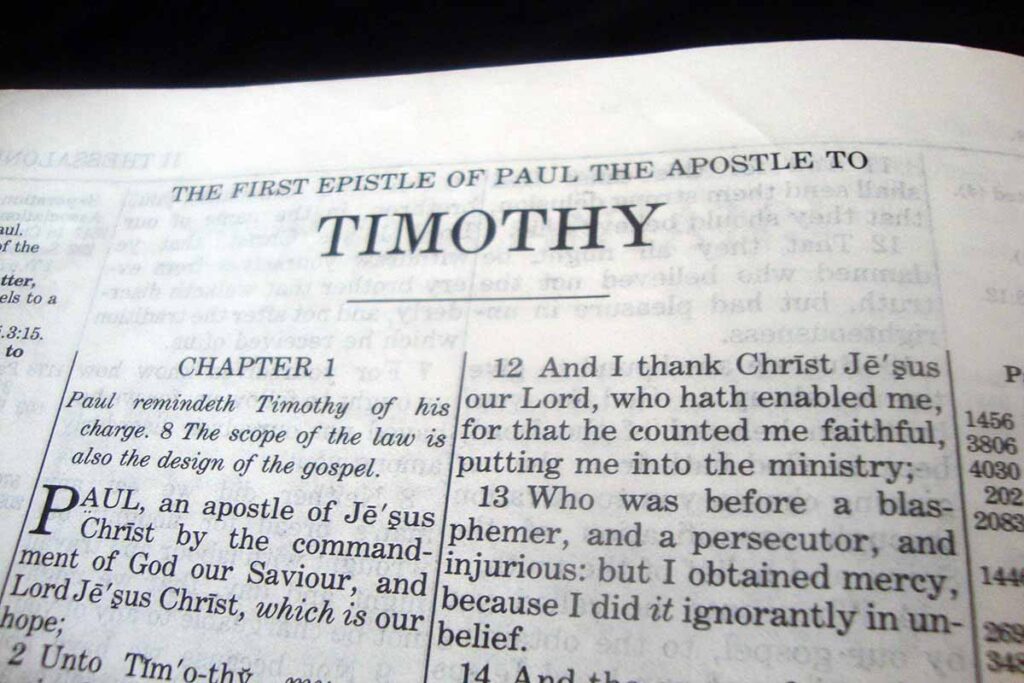The Epistle of First Timothy
The Apostle Paul wrote First Timothy in about A.D. 64, probably just prior to his final Roman imprisonment. Because he had appealed to Caesar, Paul was sent as a prisoner to Rome. Most scholars believe that Paul was released in about A.D. 62 (possibly because the “statute of limitations” had expired) and that during the next few years he was able to travel. During this time he wrote First Timothy and Titus. Soon, however, Emperor Nero began his campaign to eliminate Christianity. It is believed that during this time Paul was imprisoned again and eventually executed. During this second Roman imprisonment, Paul wrote Second Timothy. Titus and the two letters to Timothy comprise what is called the “Pastoral Letters.”
Impacting more than 20 million lives over 30 years, the Life Application® Study Bible is the #1–selling study Bible of our generation. Now, it has been thoroughly updated and expanded to be even more helpful and relevant for your life and today’s world.
Paul advised Timothy on such practical topics as qualifications for church leaders, public worship, confronting false teaching, and how to treat various groups of people within the church. Right belief and right behavior are critical for anyone who desires to lead or serve effectively in the church. We should all believe rightly, participate in the church actively, and minister to one another lovingly.
First Timothy holds many lessons. If you are a church leader, take note of Paul’s relationship with his young disciple – his careful counsel and guidance. Measure yourself against the qualification that Paul gives for overseers and deacons. If you are young in the faith, follow the example of godly Christian leaders like Timothy, who imitated Paul’s life. If you are a parent, remind yourself of the profound effects a Christian home can have on family members – a faithful mother and grandfather led Timothy to Christ, and Timothy’s ministry helped change the world.
Writer of First Timothy
Written by the Apostle Paul, “an apostle of Jesus Christ” (1 Timothy 1:1). All the Pastoral Epistles (1 Timothy, 2 Timothy, Titus) name the apostle Paul as their author. In addition, early tradition unanimously insists that Paul wrote them.
Date Written
During Paul’s post-Acts ministry (between A. D. 63-66). Paul visited Ephesus in about A.D. 63, following his release from his first Roman imprisonment. Soon thereafter, he left, placing Timothy in charge of the church there. He probably wrote the first letter in about A.D. 64.
To Whom Written
To Timothy, “my own son in the faith” (1 Timothy 1:2).
Historical Setting of First Timothy
First and Second Timothy differ in historical context. In the first epistle, Paul writes from Macedonia to young Timothy, who has been left in Ephesus to oversee the congregation. The second epistle, also written to Timothy in Ephesus, comes from Rome where Paul is undergoing a second and harsher imprisonment. Paul is alone (except for Luke, 2 Timothy 4:11), and knows the end of his life will come soon (2 Timothy 4:6).
Theological Contribution
For Paul, the best medicine for false teaching and apostasy is “sound doctrine” (1 Timothy 1:10; 4:3). The gospel is a spiritual inheritance to be received from the faithful witnesses and passed on to such. It brings about wholeness or health, not only in belief but also in good deeds.
Special Considerations of First Timothy
The Epistles to Timothy might be considered our earliest manual of church organization. Within them, we find guidelines for the selection of church leaders and an awareness of the need for standard forms of expressing the faith. Second Timothy presents the first (and only) pronouncement in the New Testament on the Bible as “Scripture” (referring to the Old Testament), “inspired” or “breathed into by God.”
Purpose
The purpose of the book of First Timothy was to outline Paul’s charge to Timothy regarding his responsibilities in Ephesus. Paul instructed Timothy how to deal with the “savage wolves” who had entered in among the Ephesian ekklesia (Acts 20:29), as well as the men from among the ekklesia who had started speaking perverse things to draw away disciples after themselves (Acts 20:30). Paul issued directives as to teaching the believers in Ephesus (mostly ancestral Israelite who had believed during the Acts period) how they should live in the dispensation of grace. Paul also instructed Timothy how to choose over-watchers (episkopos) and servants (diakonos) for the community. He beseeched Timothy to “fight the good fight of faith” as an example to the community in Ephesus. In 1 Timothy 2:5, the apostle made the astounding statement, “For there is one God, and one mediator between God and men, the man Christ Jesus,” absolutely allowing any mediation of angels or men in this present dispensation.
Recommended Bible Study Resources
ESV Study Bible – Study Bibles give you a deeper understanding of God’s Word with tools for life application like commentary, maps, charts, concordance, and study notes. Search our popular translations- NIV, ESV, NKJV, KJV and more!
Believer’s Bible Commentary: Second Edition – A Bible commentary is a written, systematic series of explanations and interpretations of Scripture. Commentaries often analyze or expound on individual books of the Bible, chapter by chapter and verse by verse. Some commentary works provide analysis of the whole of Scripture.
The New Strong’s Expanded Exhaustive Concordance of the Bible – The best concordance for word study! This exclusive new edition of a legendary classic puts generations of biblical research at your fingertips. A valuable tool for pastors, teachers, and students of the Bible.
Vine’s Complete Expository Dictionary of Old and New Testament Words – This classic word study resource allows you to study the meaning of biblical words in the original languages without spending years learning Greek or Hebrew. A great resource for students, seasoned pastors, and anyone who enjoys biblical word studies–even if they have little to no formal training in Hebrew or Greek.
Halley’s Bible Handbook – The beloved and classic Bible companion has been thoroughly updated, while retaining its time-honored features and Dr. Halley’s highly personal style, to offer even greater clarity, insight, and usefulness.
Click here to download or print the Bible outline “First Timothy – Leadership Manual“.





